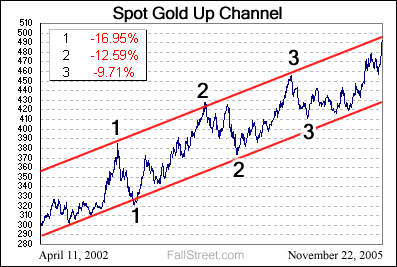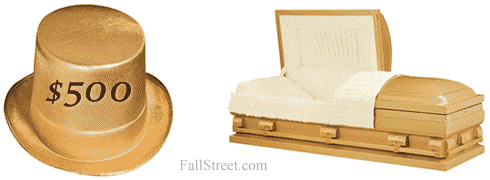|
On March 29, 1999 the Dow Jones Industrial Average closed above 10,000 for the first time. As the floor traders cheered, CNBC guests adorned “Dow 10K” rally hats, and the media wrote stories about the ‘historic’ event, the investor could not help but describe the scene idiotic. After all, whether the Dow is trading at 9999.99 or 10,000.01 makes little different to the fundamental value of the 30-stock composite.
Suffice to say, numbers like Dow 10,000 can be psychologically important over the shortest of terms, but are trivial over the longest of terms.
Gold’s Psychological Resistance Levels
Since the Washington Agreement was penned in 1999 (which occurred shortly after gold tested $250 an ounce), gold has had to battle two psychologically important trading levels. The first battle to regain $300 an ounce was waged for almost 3-years, and was not broken until the sixth try. The second battle, at $400 an ounce, began on December 2003 and probably ended after nine attempts in September 2004. What about the third battle? December gold reached an intra-day high of $495.9 an ounce yesterday…
Rally hats or the death of the latest bull rush?
Before speculating on what may happen if, and when, $500 an ounce is touched, a quick overview of the gold market is prudent. First and foremost, since holding above $300 an ounce in 2002 the gold bull – at least when studying the COT statistics - has been a relatively predictable animal. Today the COT numbers are screaming sell, and will likely continue to scream sell until the commercials are able to cover part of their position at lower prices. As for the possibility of the commercials covering for losses and/or defaulting, since this is only going to happen once (and will likely result in a full out gold mania), it is difficult to suggest that the recent rally in gold is the rally. Speculations about the commercials being cornered have emerged during every major rally since 1999, and have repeatedly been proven wrong.
Another point of interest relating to gold is the positive demand fundamentals. As more investors begin to fear inflation gold’s safe haven status has reemerged, as hedge funds cash out some of their oil/equity bets a well pocketed commercial enemy has climbed on the long side, and as central banks realize the folly of paper currencies the prospect of unexpected central banks sales is dissipating. That these positives are in play, not to mention the bullishness of producer dehedging and USD decoupling, is reason enough to suggest that gold’s uptrend will remain intact regardless of any potential correction.
 |
With these things in mind, you would think that a firm handle on what will happen when $500 an ounce is touched can be made. Unfortunately it can not. Rather, anecdotal information suggests that demand in India is hitting a wall (this is bearish), the extra tiny small spec net long position suggests that the herd has not joined in the party (this is bullish, but maybe the small players are in GLD?), recent history suggests that a break above $500 an ounce will not be sustained on the first try (bearish), and common sense says that if gold attracts anymore attention some central banks will try to suppress the price of gold by dumping more gold (at least those central banks whose interests are aligned with US dollar hegemony).
So what can really be said about $500 an ounce? That something exciting will happen when it is touched because it is a psychologically important trading level. In the context of keeping up the boring unbacked fiat norm, you have to think that any more excitement marks a near term top.
Forget about $500
Gold will one day tackle $600, $700, and $800+ an ounce USD, and by then discussion about $500 an ounce gold will be forgotten. But these days are unlikely to arrive until either the US dollar bear |
